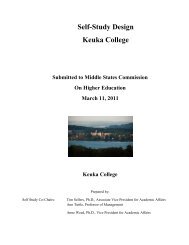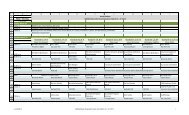final version of the self-study document - Keuka College's Middle ...
final version of the self-study document - Keuka College's Middle ...
final version of the self-study document - Keuka College's Middle ...
Create successful ePaper yourself
Turn your PDF publications into a flip-book with our unique Google optimized e-Paper software.
Table 5.6 below shows <strong>the</strong> value <strong>of</strong> <strong>the</strong> academic intervention provided by <strong>the</strong> ASK Office. Of<br />
<strong>the</strong> 268 students given an academic warning in Fall 2011, <strong>the</strong> majority <strong>of</strong> those students who<br />
used <strong>the</strong> ASK Office services (60%) went on to receive a passing grade, whereas only 51% <strong>of</strong><br />
those students on warning who did not use ASK Office services received a passing grade.<br />
Overall, students on warning who worked with <strong>the</strong> ASK Office were more successful in<br />
completing <strong>the</strong>ir courses than students on warning not working with <strong>the</strong> ASK Office; whereas 18<br />
percent <strong>of</strong> ASK students on warning did not receive a passing grade, 27 percent <strong>of</strong> <strong>the</strong> non-ASK<br />
students on warning did not receive a passing grade.<br />
Table 5.6: Fall 2011 Academic Warnings and ASK Office Intervention<br />
Students<br />
receiving<br />
academic<br />
warnings (268)<br />
Students who<br />
worked with ASK<br />
staff (120<br />
students)<br />
Students who did<br />
not work with<br />
ASK staff (148<br />
students)<br />
Received passing<br />
grade <strong>of</strong> C-<br />
Withdrew from<br />
or failed course<br />
Total percentage<br />
not receiving<br />
passing grade<br />
72 students (60%) 48 students (40%) 18% (48<br />
students/268<br />
receiving<br />
warnings)<br />
76 students (51%) 72 students (49%) 27% (72<br />
students/268<br />
receiving<br />
warnings)<br />
Also identified in Table 5.7 is <strong>the</strong> fluctuating percentage <strong>of</strong> students who seek ASK services after<br />
receiving a warning, going as low as 36% in Spring 2010 and as high as 53% in Fall 2010. To<br />
address this discrepancy, <strong>the</strong> ASK pr<strong>of</strong>essionals are now going into FYE 101 classes as well as<br />
o<strong>the</strong>r first year classes, to emphasize <strong>the</strong> positives <strong>of</strong> seeking ASK services (higher grades,<br />
improved time management and <strong>study</strong> skills) while dispelling any myths that ASK is <strong>the</strong><br />
equivalent <strong>of</strong> a high school resource room <strong>of</strong>fered only to students with disabilities.<br />
Table 5.7: Academic Warnings and Utilization <strong>of</strong> ASK Services 2008-2012<br />
Traditional<br />
Program ASK<br />
Office Data<br />
Number <strong>of</strong><br />
academic<br />
warnings<br />
issued<br />
Number <strong>of</strong><br />
students who<br />
received warnings<br />
Number <strong>of</strong><br />
those students<br />
receiving<br />
warnings who<br />
used ASK<br />
services<br />
Number <strong>of</strong> those<br />
students who go on to<br />
receive C- or better in<br />
course work for<br />
which <strong>the</strong>y received a<br />
warning<br />
Fall 2008 469 252 103 or 40% 92 or 89%<br />
Spring 2009 327 162 82 or 50% 47 or 57%<br />
Fall 2009 265 165 65 or 39% 30 or 46%<br />
Spring 2010 216 142 52 or 36% 27 or 51%<br />
Page 20 <strong>of</strong> 39 Chapter 5: Admissions, Retention & Support




